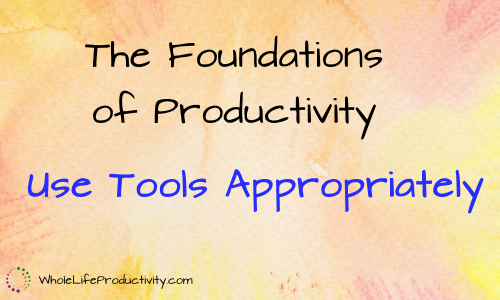
Use Tools Appropriately: The Foundations of Productivity

Want A Summary of the Series?
Become a Legacy Patreon Subscriber and get access to all past Patreon rewards, including the exclusive summary of all the Foundation articles!
There is a tool for everything. Take a look around any home improvement store, and you will see exactly what I mean. But even with this variety of tools, it is still tempting to use a tool inappropriately. It is important to the success of the project for you to use tools appropriately.
Productivity requires a solid foundation if the methods are going to be successful. Just like every building must have a solid foundation if it is going to remain standing, productivity must also have a solid foundation unless you want it to crumble underneath you.
We are in a ten-article series on the foundations of productivity. Today we will look at another fundamental rule: use tools appropriately.
The Wrong Tool…An Example
Here is an example of what I mean, outside of productivity. When I was in college, I needed to put a nail into the wall. I couldn’t be bothered to go get the hammer from my roommate’s tool kit. After all, I had a shoe. The first few shoes I tried had soles that were too soft to be able to push the nail in. So I ended up with a pair of pumps which just happened to have a heel made out of steel. It did eventually get the nail into the wall, but it ended up causing damage to both the wall and my fingers in the process. Plus it took about three times as long as it would have for me to fetch the hammer from the kitchen and do the job properly.
The shoe did the job, but it wasn’t efficient, and ended up causing damage.
The Wrong Productivity Tool
I so often see people using the wrong productivity tools as well, and they end up being inefficient and causing damage as well.
I see people putting all their tasks on the calendar. I see people putting all their appointments in their task lists. I see people using task lists as project trackers (raising my hand here). I see people using email as their calendar, task list and project trackers combined. I see people using note software to mix it all together. I see people putting notes in their calendars…after all, why else would there be a notes field?
The argument could be made that you are being efficient by keeping everything together. But the truth is that mixing things up means that you can’t distinguish one type of item from another. And once you have homogenized them, the importance is diluted, and things end up getting lost in the shuffle. Therein lies the danger. If you can’t get information out of your productivity system, you might as well just flush it down the toilet to begin with.
The Danger of Mixing
The danger of mixing types of information is that you end up being able to distinguish things in their importance.
Let’s say that you use your calendar as your to-do list. You have your appointments on there, and then you mix in all of the things that you intend to do that day. Let me emphasize that: intend to do that day. So you are going along with your day, and by 9 a.m., your schedule is already off because your first client was late. But your calendar is full, so you careen into the day, trying to cut corners in a desperate effort to get back on track. And then you are late for your second meeting, because you were trying to stick to the schedule.
Oops.
If a task has to be done only at a certain time, there is nothing wrong with putting it on your calendar. However, using it as a target list is just asking for trouble. No calendar ever runs exactly as planned.
Recognizing the Wrong Tool
So how do you recognize what is the right tool and what is the wrong one?
Most adjustment to productivity systems needs to occur when you realize that something isn’t working as well as you would like it to. That isn’t a license to fiddle, but rather a step to innovation.
The first step lies in figuring out what exactly the intended use of the tool is. A calendar is meant to track appointments – things that happen at a specific date and/or time. A task list is meant to track things to do. A notebook is meant to write down notes and thoughts as they occur.
The second step is looking at how you get information out of your system. If you are using a calendar for appointments, but then storing meeting notes in with the appointment, how are you getting that information out? You are having to rely on your memory of when the appointment occurred in order to find out what actually happened. Ask yourself if you can get the information out efficiently and (more importantly) directly.
The thrid step is looking at any other difficulties in how you are using the tool. If someone called you to ask if you could do an interview with Oprah sometime in the next few hours, would you be able to give a definite answer with one glance? Or would you have to wade through irrelevant information? If someone asked you if something is on your task list, could you find it (or its absence) easily? Are there any leaks in the tool that cause information to be lost or overlooked?
Finding the Right Tool
When you are looking for a right tool, the first thing is to evaluate what you need, rather than trying to fit yourself into the tool.
What do you need to accomplish? Do you need a place to track appointments? A central place to put all your notes? How do you need to put in the information? Where and when do you need access? With whom do you need to share the information? What shared information do you need to access?
All of these questions are things that you need to consider. Figure out what you need — bare bones minimal — and then figure out what the nice-to-haves are. Then, and only then, select a tool to get the task accomplished.
Conclusion
Using a tool inappropriately is just as detrimental to a productive life as not using any at all. Mixing information leaves all the information clouded or inaccessible. By looking at the tools you are using and taking the time to find the right tool for the job, you will be well on your way to a better and more productive life.




